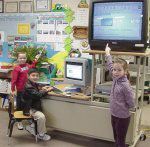Stars and STEM Stories
Highly Decorated Teacher Credits GLOBE for Her Success
Edna Escudero Boggess's second-grade classroom at Cambridge Elementary school in San Antonio, Texas is festooned with the flora and fauna of a tropical jungle. A native of Puerto Rico, this GLOBE teacher uses the rain forest theme to help her students understand their lessons in environmental health and ecological diversity.
And recently she has been collecting teaching honors the way some people collect stamps. "She supercharges her content and brings it to life," said John Moore, Ed.D., chairman of the education department at Trinity University in San Antonio, TX, referring to why Escudero Boggess won his school's prestigious teaching award. "She is absolutely dedicated to the idea that all kids can learn."

The 20-year-old Trinity Prize for Excellence in Teaching, "recognizes truly outstanding San Antonio public school teachers and honors teaching as a profession," according to a statement released by the university. About 20 teachers are recognized each year, and a couple are chosen from that group for the top prize, a cash award.
Escudero Boggess also had garnered Texas's Region 20 Elementary Teacher of the Year award. That award, part of the Texas Teacher of the Year program, goes to only 20 teachers in the state.
"A lot of people don't give elementary teachers credit for making a difference," Escudero Boggess said. "But elementary school kids can learn things scientifically from the very beginning, it becomes part of their existence, it becomes natural."
She mentioned GLOBE in her applications for the awards because she believes the Program has provided a good background for her own approach to teaching all subjects.
"GLOBE makes science more than a lab course, it makes your life the lab. We're taking it out of the classroom. Everything I do is in the correct scientific vocabulary."
Escudero Boggess has confidence in her students' ability to develop critical, scientific thinking skills, despite their age.
"These are second-graders, but no student is too young for any aspect of GLOBE," she said. "It's easy to start them with the truly scientific. For example, while we haven't done formal MUC observations, I do talk about land cover on their level.
"In our classroom, weather is not just a unit, it's a part of every day, and the cloud readings are a part of every day. They also see how the thermometer is applied and used in science," she continued. "We look at our piece of the world and compare it to the rest of the United States. The students are thinking scientifically. They make predictions about the weather and the kids are challenging the weathermen, and most of the time we're doing better than they are!"
Escudero Boggess opted for GLOBE training on her own a few years ago to enrich her teaching skills. Although GLOBE training was available closer to home, she decided to be trained in Boulder, CO, during her vacation, in order to see a new part of the country.
"I liked GLOBE when I heard about it and I wanted to be have a broad-base as a teacher," she said. "I have a lot of fun. I've been able to get honors for doing things that I love to do and for the extra things, too, that I do out of my natural curiosity."
23 April 2001





